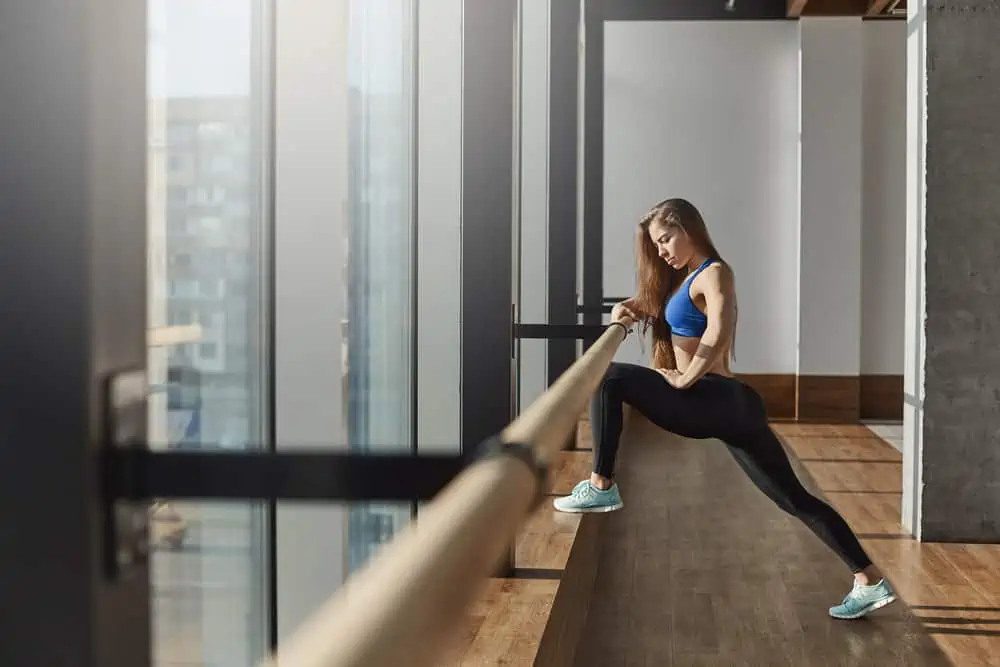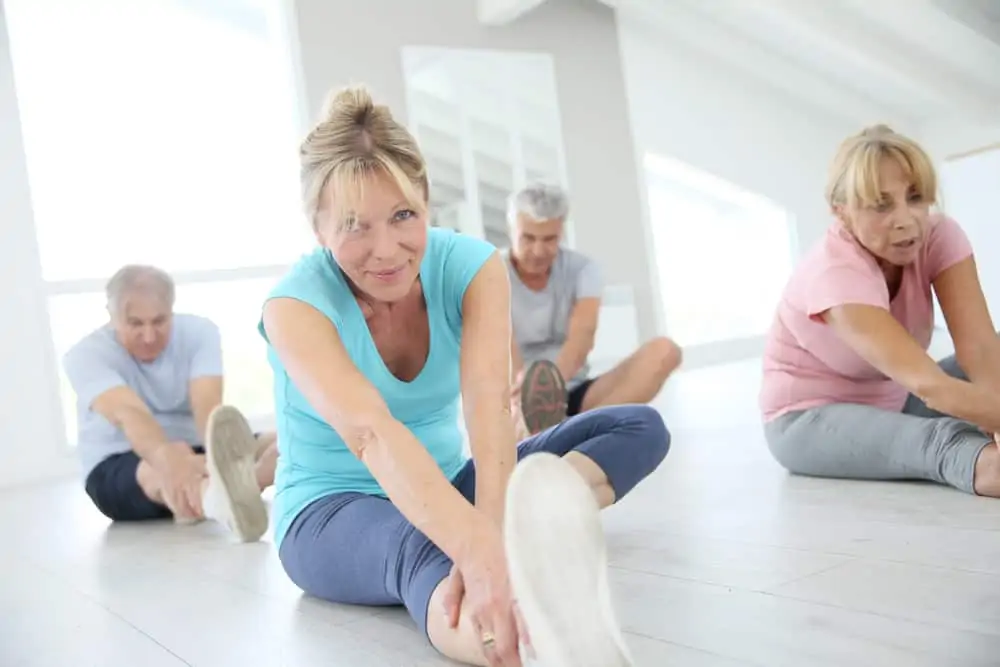This page contains affiliate links. I’m part of the lululemon collective and will receive a commission if you make a purchase through the links below. As an Amazon Associate, I earn from qualifying purchases. Read the full disclosure here.
Both barre fitness and Pilates are popular fitness class formats found at studios and gyms.
You can even get an amazing workout at home with minimal equipment.
But which one is right for your workout routine? You’re in luck.
Keep reading to see how these two workouts stack up against each other in this comprehensive barre vs. Pilates showdown.
What is barre fitness?
Barre fitness is a low-impact workout format that fuses dance, Pilates, and yoga elements for a fun and challenging workout targeting your entire body.
Don’t panic, no previous dance experience is required.
As history tells it, barre workouts originated with the German ballet dancer Lotte Berk in the 1950s. The story goes that she was looking for ways to stay fit while working around a back injury. And thus, the early states of barre fitness workouts were born.
Barre classes typically include upper body exercises with light weights, ballet-inspired body weight standing exercises focusing on thigh (quadriceps), seat (glutes and hamstrings) strengthening, and core strengthening movements.
In most classes, movements are choreographed with the beat of the music and focus on isolated, controlled strengthening motions and time under tension to improve overall strength.
Time under tension is the amount of time a muscle is held under stress (or working) during an exercise set. Barre typically combines several different contractions and ballet inspired movements within the same series to work a muscle group to fatigue.
High reps with low weight micro-movements are a little different than traditional strength training, and even the very strong may find themselves struggling during a barre workout.
Isometric exercises make a frequent appearance in barre classes and the barre “shakes” are a real thing. As you begin to fatigue, you might find your legs shaking uncontrollably. The first time, it can be a little disturbing, but it’s a good thing in barre.
Though the weights are light, you’ll definitely build some muscular endurance in this workout.
This article in self magazine dives deeper into the science behind micro-movements and muscular strength in barre and Pilates.
Some standing exercises use positions in releve, which is on your toes; however, if this is not comfortable, you’re welcome to keep your feet flat on the ground or add a yoga mat for additional padding.
Barre can either be done barefoot, with grip socks or with lightweight ballet-style shoes for extra padding while allowing full range of motion in your feet. (Some barre studios may have policies that you need to wear socks.)
I also like this option from Bloch, a dance shoe company. These shoes are specifically for Pilates or barre and have a more structured heel cup with plenty of flexibility for your feet.
There are many different barre fitness formats. In my opinion, some are better than others. Not all exercises are created equal, and some target strengthening much better and provide more bang for your buck.
My advice? Try different classes to see which formats you prefer.
Some popular barre studios are Bar Method, Xtend Barre, Pure Barre, Booty Barre, and Physique 57.
You can also find many other formats of this popular workout offered as group classes in your local gym.
Benefits of barre exercise
- Incorporates low impact strength and cardio elements for a full body workout
- Improves posture
- Improves balance
- Improves flexibility
- Provides more opportunities for lower body strengthening
- Improves coordination, mind-body connection, and focus
- Options for multiple fitness levels
- Helps with weight loss/maintaining a healthy weight
Maintaining good form is important for all exercises, but is especially important in barre exercises. Slight changes in angles and leg rotation for various exercises go a long way to protecting your body and properly engaging each muscle group to maximum results.
Be sure to pay close attention to the alignment cues provided by your barre instructor. Subtle changes can make a world of difference.
Tips for keeping your feet comfortable in barre class
Barre fitness is typically performed without shoes. Barefoot helps improve foot strength, especially for the foot’s intrinsic muscles that don’t get worked and wearing padded shoes most of the day.
Not wearing shoes can be uncomfortable for various reasons, especially when it comes to some of the exercises performed standing on your toes.
Barre studios are usually equipped with padded floors, however many multi-use studios are standard wood flooring.
Here are some tips to increase your comfort during a barre class:
- Grip socks can provide additional padding and help keep you from sliding on the floor
- Ballet or Pilates shoes can also provide padding
- Double a yoga mat to stand on for additional comfort underneath your feet
- Opt to keep your heels lower to lessen pressure on the ball of the foot
Remember, you don’t have to rise on your toes if it’s not comfortable.
Keeping your feet flat will decrease your range of motion, but it’s always an option to make exercises more accessible.

What is Pilates?
Pilates is a mind-body exercise format that incorporates breathing with slow, coordinated, and intentful movements.
A regular Pilates practice can help develop muscle strength for the core and posture muscles, coordination, improve posture, flexibility, mobility, activities of daily living, and promote overall well-being.
Pilates was made famous by Joseph Pilates, who invented the method (previously known as Contrology) to improve strength for the body and mind.
Pilates essentially crafted a first generation of the Reformer machine while in a WWI internment camp to help rehabilitate other soldiers.
Classical Pilates followed an original set of 34 mat exercises in the same order each time. Today, Pilates is a popular exercise format that has branched into several different styles but retains the underlying principles of coordination and control.
Mat Pilates vs. Reformer Pilates
Mat Pilates is performed at gyms, studios, and can even be done at home, making it a very accessible form of exercise.
Exercises are done in various positions, including standing, sitting, prone, side-lying, and supine.
Small apparatuses such as light weights, the Pilates ring, mini ball, or gliders are commonly used during mat Pilates classes to add a different challenge or variation to exercises.
A mat Pilates workout is an excellent option for beginners to advanced participants due to the wide range of possibilities and challenges.
Another Pilates format uses a large piece of equipment called the Reformer.
A reformer looks like a sliding platform hooked up to various pulleys and springs to add resistance to different exercises.
Though it may appear intimidating, the reformer can be used by beginners to advanced practitioners and can provide an additional challenge for advanced Pilates over a mat Pilates class.
The downside to reformer classes is that they tend to be very expensive and require equipment that you’ll need to visit a specialty studio and work with a qualified instructor.
Benefits of Pilates
- Low impact strengthening
- Improves posture and integration of core muscles with breathing and movement
- Improves balance
- Improves flexibility
- Improves breathing patterns
- Improves coordination, body awareness, and focus
- Options for multiple fitness levels
- Helps with weight loss/maintaining a healthy weight
The benefits of Pilates and barre may seem almost identical.
There are always exceptions, but typically barre classes have a higher amount of cardio due to more time spent performing standing exercises. Pilates classes will focus more on core integration and breathing with various strengthening movements.
If you have osteoporosis concerns, read this article outlining movements to avoid to keep your spine safe during mind-body workouts. This article focuses on Pilates, however, the precautions and takeaways are applicable to many workout formats.
Where to try barre fitness and Pilates
Many gyms have barre and Pilates (typically mat Pilates) classes on their schedules.
Private studios also offer these formats. Some examples are Bar Method (which is my favorite), Pure Barre, Club Pilates, Barre 3, and Physique 57.
You can also check out Class Pass to find local studios in your area and get deals on classes.
Both formats have their own set of terminologies used. Look into a beginner class to learn the basics if you’re new.
Barre and Pilates can easily be done at home with plenty of access to video workouts. YouTube has a variety of free workouts in both formats.
If you’re looking for more variety, definitely check out ALO Moves. ALO Moves is way more than just yoga, with access to hundreds of fitness classes including Pilates, barre, cardio, and strengthening. They often run deals for free trial periods.
At a studio, you’ll have access to a sturdy ballet barre. At home, you can use a chair, countertop, or even have your own barre set up.
Below was my fancy at-home barre set up during the height of the pandemic. I like this barre because it’s not too bulky, has multiple heights, and can easily be folded away inside its carry bag. I’ve moved a few times and it’s very easy to quickly assemble and take down as needed.
While I don’t know if this one is still available on Amazon, there are plenty of similar options. Here’s another at-home barre option with room for your hand weights.

Barre & Pilates myths
Fitness myths are all around, and barre and Pilates are no exceptions.
It’s common to hear misleading phrases like “muscle lengthening” with these types of fitness formats.
While both barre and Pilates incorporate postural muscle strengthening and flexibility which contributes to healthy posture, your muscles aren’t actually getting longer. Muscles have fixed end-points and can only contract and relax so much.
“Muscle toning” is another popular phrase thrown around. What does “tone-up” really mean? This phrase typically means, lose fat and build lean muscle for a “fit” look, whatever that means to you.
Barre and Pilates can be a helpful part of a well-rounded fitness program, it’s important to align your fitness routine with your desired goals. If building muscle is high on your list, then it’s essential to include heavier weight lifting, including compound movements, alongside a solid nutrition plan.
This article in the Washington Post takes on a popular barre fitness myth addressing why you shouldn’t expect a ballerina body just from taking a barre class.
Wrapping up barre vs. Pilates
Adding barre fitness and Pilates into your routine is an excellent way to improve your postural and core strength.
Both workouts are fun, challenging, have options for any fitness level, and can help you meet your health and fitness goals.
Which workout is your favorite?







I read your blog. Having very use full information help me a lot. I will read more articles on your blog.